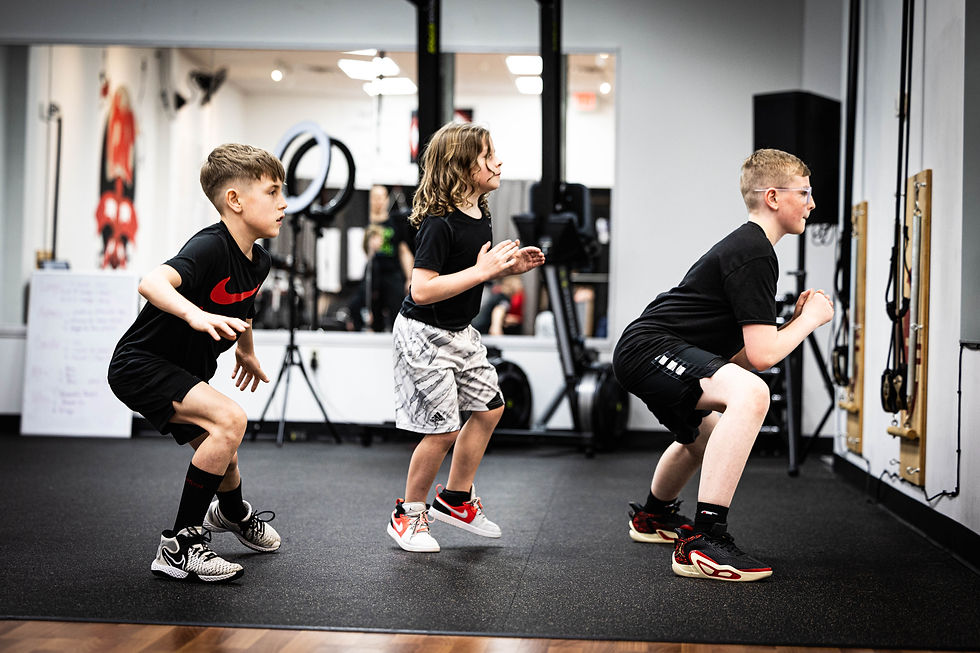"Uncovering the Benefits of Youth Resistance Training: What Parents Need to Know"
- Laura Baden
- Jun 7, 2024
- 3 min read
As a fitness professional, one of my top priorities is ensuring the safety and well-being of my clients, especially when it comes to youth training. Weight training for young individuals can offer a myriad of benefits, including improved strength, athleticism, coordination, and confidence
However, it's crucial to approach youth weight training with caution and mindfulness to prevent injuries and promote long-term health. In this blog post, we'll explore the key principles of safe weight training for youth, backed by research and best practices in the field.
Understanding Body Weight:
Before diving into weight training with external loads, it's essential to emphasize bodyweight exercises. Bodyweight movements such as squats, lunges, push-ups, and planks help develop foundational strength and teach proper movement patterns without added resistance. Research suggests that bodyweight training can effectively enhance muscle strength and endurance in youth while minimizing the risk of injury associated with heavy external loads.

Emphasizing Movement Training:
Incorporating movement-based exercises into youth training programs can enhance agility, balance, and coordination. Activities like agility drills, ladder exercises, and dynamic stretching not only improve athletic performance but also reduce the likelihood of injury by enhancing proprioception and body awareness. Movement training should be integrated into weight training sessions to promote functional strength and injury prevention.

Developing Core Strength:
A strong core is essential for stability and proper biomechanics during weightlifting movements. Youth athletes should focus on exercises that target the core muscles, including the abdominals, obliques, and lower back. Planks, Russian twists, and stability ball exercises are effective for developing core strength while minimizing stress on the spine. Emphasizing proper core engagement throughout training sessions can enhance overall performance and reduce the risk of injuries.

Prioritizing Proper Form:
Proper form is paramount when it comes to weight training, especially for youth athletes whose bodies are still developing. Teaching proper lifting techniques from the beginning can prevent injuries and ensure optimal muscle engagement. Emphasize the importance of maintaining a neutral spine, proper joint alignment, and controlled movement throughout each exercise. Start with light weights or resistance bands to allow youth athletes to master proper form before progressing to heavier loads.
Professional Supervision:
Youth weight training should always be conducted under the supervision of a qualified fitness professional or coach. A knowledgeable instructor can provide guidance on proper exercise selection, technique, and progression based on the individual needs and abilities of each youth athlete. Supervision also ensures that safety protocols are followed and potential risks are minimized during training sessions.

Appropriate Progression:
Progressive overload is key to continuous improvement in strength and performance. However, progression should be gradual and individualized to accommodate the unique growth and development patterns of youth athletes. Focus on increasing resistance, volume, or intensity gradually over time, taking into account factors such as age, experience level, and training goals. Avoid pushing youth athletes beyond their limits or sacrificing form for heavier weights.
In conclusion, weight training can be a safe and effective way for youth athletes to enhance their strength, athleticism, and confidence when approached with care and consideration. By prioritizing bodyweight exercises, movement training, core strength, proper form, professional supervision, and appropriate progression, we can empower young individuals to reach their full potential while minimizing the risk of injury. Let's create a positive and supportive environment where youth athletes can thrive and develop lifelong habits of health and fitness.
References:
Faigenbaum, A. D., et al. (2009). "Youth Resistance Training: Updated Position Statement Paper From the National Strength and Conditioning Association." Journal of Strength and Conditioning Research, 23(Suppl 5), S60-S79.
Lloyd, R. S., et al. (2014). "Position statement on youth resistance training: the 2014 International Consensus." British Journal of Sports Medicine, 48(7), 498-505.
Myer, G. D., et al. (2014). "Youth resistance training: updated position statement paper from the National Strength and Conditioning Association." Journal of Strength and Conditioning Research, 28(6), 2654-2676.




Comments